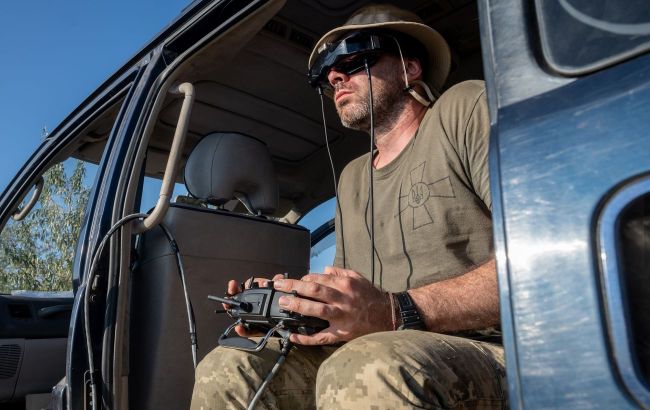Art of war in 21st century: How Ukraine breaks patterns and changes the rules on the battlefield
 Photo: Ukrainian army challenges common military axioms (GettyImages)
Photo: Ukrainian army challenges common military axioms (GettyImages)
The Ukrainian army, in an attempt to withstand the superior enemy, demonstrates an unconventional approach to conducting military operations. What surprises the world about the Ukrainian Defense Forces is detailed in the material by RBC-Ukraine.
To prepare the material, sources such as personal conversations with military experts mentioned in the article, statements from the General Staff and the Ministry of Defense, and Defense Express were used.
The war of Russia against Ukraine has been meticulously studied by military theorists and practitioners around the world from its very beginning. The bloodiest conflict in Europe in the last 70 years provides insights into what combat operations might look like in the 21st century. Essentially, new lessons in the art of war are currently being written in southern and eastern Ukraine.
Western doctrine after World War II had long emphasized swift special operations. Even the large-scale invasion on February 24th was planned to some extent within NATO parameters, with a Russian "flavor." However, the war in Ukraine is forcing the world to reconsider what were considered axioms of national security and military operations.
In the air
Since World War II, air superiority has been considered a key condition for the success of combat operations. To achieve this, it is necessary to neutralize the enemy's aviation and suppress its anti-aircraft defense. In this sense, Russia did not introduce anything new when it started its special military operation with missile strikes on Ukrainian airfields, radar unit locations, and air defense systems.
At that time, our arsenal consisted mainly of Soviet SAMs (Surface-to-Air Missiles), MANPADS (Man-Portable Air Defense Systems), anti-aircraft artillery, bombers, and attack aircraft in limited quantities. However, even then, something resembling a layered air defense system had been established, where various systems – long-range, medium-range, and short-range – operated in coordination. Moscow did not take this into account, nor did it consider that shortly before the first attack, our command had dispersed aircraft and air defense assets.
The exact scale of losses from enemy strikes on the first day is unknown. However, despite the pressure from enemy aviation, missiles, and later drones, the Ukrainian air defense was not only able to maintain its combat capability but also to strengthen and continue repelling aerial attacks. In the history of modern wars and conflicts, we will not find such a massive workload on an air defense system as the Ukrainian one has faced for the past nineteen months.
"Given the modifications of the MiG-29, Su-27, their aviation weapons, and our air defense system as of February 24, in theory, we should not have been able to withstand a Russian airstrike. But something went wrong in our favor. By the way, it is a mistake to think that the transfer of F-16s to us with the corresponding weaponry will lead to a breakthrough or advantage in the air. In fact, it will give our aviation the same capabilities that the Russians have now," says Ivan Kyrychevskyi, an Expert at the Defense Express Media and Consulting Company.
.jpg)
Patriot air defense system shoots down advanced Russian missiles (Photo: GettyImages)
Thanks to Western Patriot air defense systems, our army became the first in the world to shoot down hypersonic Kinzhals. The Russian-Ukrainian war is the first conflict in which hypersonic weapons are used. Although it is believed that the real speed of Kinzhals does not reach hypersonic levels.
These missiles appeared in Moscow in 2017, China has its hypersonic weapons but is still expanding its arsenal, and the United States is still developing them, according to Kyrychevskyi.
"There have been no conflicts where hypersonic weapons have already been used. Unfortunately, we became the first to test it. Interestingly, it was believed that the Patriots couldn't shoot down such fast targets. They would need something more powerful, like the American THAAD. Maybe our anti-aircraft gunners didn't know that Patriot didn't have this option, so they launched it and successfully shot down the Kinzhals. Otherwise, it can't be explained, as it was even a surprise for the manufacturers," explained the expert.
There were other examples of creativity by our military, such as using Javelin complexes, designed to hit tanks, to shoot down an airborne target for the first time in history. This refers to the Russian Ka-52 helicopter, which was destroyed in early July on the Berdyansk front. Before that, Ukrainian fighters had already shot down Russian helicopters with other anti-tank missile systems - Stuhna and Korsar.
In the first months, the Russians struck not only with long-range missiles but also with aviation weapons. However, due to the fact that the enemy could not suppress our air defense, Russian aircraft, and helicopters have been operating only in the near-front zone, at low altitudes, and have not penetrated deeper into Ukraine since April of last year. Although our military still manages to target them, either in the occupied territory or directly on the territory of the Russian Federation.
"Ukraine, practically without physically acting on the territory of the Russian Federation, destroys its transport and strategic aviation, missile carriers, bombers Il-76, Tu-22M3, Tu-95MS. Moreover, this influence extends deep into the enemy's territory not with missiles, but with completely different means," added military and political expert of the Information Resistance Group, Oleksandr Kovalenko.
Another example of the Ukrainian army's creativity is the installation of pylons from decommissioned Tornado strike aircraft on Su-24s, allowing our Soviet bombers to launch Western long-range missiles Storm Shadow / SCALP-EG.
At sea and on land
Ukraine is waging war against an enemy that not only possesses a significant advantage in its air force but also in its navy. However, this has not prevented our army from greatly reducing the enemy's ability to conduct amphibious operations in the Black Sea – nearly half of its landing ships from the Black Sea Fleet have already been damaged or destroyed.
Recently, Ukrainian military forces, for the first time in history, struck a submarine with a cruise missile. We are talking about the Rostov-on-Don, which was damaged in the occupied Sevastopol. Last year, there was another new precedent in naval warfare when the Russian Black Sea Fleet flagship, the missile cruiser Moskva, sank after being hit by Ukrainian Neptun missiles. After such losses, it can hardly be called a fleet anymore – more like a flotilla.
Lately, the Russian Black Sea Fleet has been plagued by maritime kamikaze drones – another unique development of ours. Ukraine is not the first country in the world to attempt to develop such drones, but it is the first to successfully bring it to fruition and put it into practical use.

Ukrainian maritime drones (Photo: U24)
"Iran used something similar. But it was just a makeshift boat packed with explosives, with a crew. They aimed it at an enemy ship, and the pilot would jump out before the impact and head for the shore," Kovalenko explained.
According to Kyrychevskyi, there are currently about 130 types of maritime drones for various purposes in the world. These include traditional surface boats, small robots used on minesweepers for clearing sea mines, and unmanned underwater vehicles.
"But it turns out that in this regard, we are ahead of the rest of the world because we have actually created a working model of a maritime kamikaze drone – a small surface object with a powerful charge that can reliably destroy something. In fact, we are the first to use them in real combat conditions and gain practical experience in their application," the expert explained.
During the war, both the Ukrainian and Russian armies have scaled up their previously developed experience in using drones. In the first year of the war, about 70% of drones were supplied from abroad, while 30% were domestically produced. However, in 2023, we have almost the opposite situation. The most intensive use of drones has been observed by Azerbaijani forces during the Second Karabakh War, according to Kovalenko.
In addition to aerial and maritime drones, Ukraine also has domestically produced ground drones that are used, for example, for landmine clearance, the expert noted.
"You can say that Ukraine has embraced drone-centric warfare, where drones are the primary means of tactical reconnaissance. This allows commanders at the tactical level to have real-time situational awareness, effectively carry out missions, and engage the enemy. When you have complete situational awareness, knowing the enemy's location, their objectives, and the terrain characteristics, it's a whole different level of warfare than it was even 10 years ago," explained Mykhailo Samus, the director of the New Geopolitics Research Network, in a conversation with RBC-Ukraine.
Finally, the fact that a country significantly smaller in terms of population, economic, and military potential has withstood the onslaught of the hypothetical "second army in the world" is also a unique aspect of Ukraine's situation. Such precedents are extremely rare in modern history. One example is the Winter War in 1939-1940 when the Soviet Union attacked Finland. However, the scale of the fighting in Ukraine has already surpassed that. Moreover, despite the numerical superiority of the enemy, the Ukrainian Defense Forces not only hold the defense but also carry out offensive operations and step by step reclaim occupied territories.
.jpg)
Ukrainian military achieves success without numerical superiority over the enemy (Photo: Ministry of Defense of Ukraine Facebook)
"Currently, there are over 100,000 personnel from the Russian side in the Azov region (East Army Group). This is three times more than the Ukrainian Defense Forces units participating in the offensive actions. Moreover, the Russians have an exaggerated defensive line. For instance, the first line has an extremely large number of anti-personnel and anti-tank obstacles. But we managed to break through it in fairly standard terms. This is a unique case – we are advancing with much smaller forces in an extremely challenging zone, and we are advancing successfully," Kovalenko pointed out.
***
When all Western analysts, experts, and officials were giving us apocalyptic forecasts before the large-scale invasion, they were actually basing them on objective conditions, says Kyrychevskyi. The Russians had concentrated forces near our borders, both in terms of quantity and quality, sufficient to conduct operations according to NATO standards.
"Furthermore, the theory of conducting military operations according to NATO standards involves striking airfields, military-political command structures, military infrastructure, and then everything in the country falls apart. But thanks to the resilience of our military and the self-organization of society, we managed to avoid this collapse and withstand as a state," the expert clarified.
In Russia's war against Ukraine, there have already been numerous critical situations that no one in the world had previously modeled. It turns out that the Defense Forces handle them more successfully than one could have imagined.
"It's not even about breaking established rules. It's about writing new patterns for how war can take place in the 21st century on the battlefield in Ukraine," added Kyrychevskyi.
What lessons can the world learn from this? You may have a strong fleet, powerful aviation, and modern tanks. But without a layered ground-based air defense system, the enemy can effortlessly disable your power grid with missile strikes.
You can argue as much as you want that artillery has taken a back seat in combat operations. However, reality shows that it remains indispensable both in offense and defense. Ultimately, the advantage will go to those who have precision and speed in hitting targets.
Drones should be relatively inexpensive as expendable assets and present in all branches of the military – on land, at sea, and in the air.
Quantity matters. We can ask for Patriot or F-16 transfers for a long time, but they will only impact the course of the war if there are enough of them.
However, one of the main lessons is that the era of short and lightning-fast operations did not replace large wars like the First or Second World Wars. And in this era, it is impossible to win without unconventional thinking and a fervent will to fight.

